Application of Play in Childhood Education: Benefits and Theories
VerifiedAdded on 2021/04/24
|13
|3450
|13
Essay
AI Summary
This essay explores the application of play in childhood education, emphasizing its importance for cognitive, physical, social, and emotional development. It examines various play theories, including psychoanalytic and cognitive perspectives, highlighting the contributions of theorists like Freud, Piaget, and Vygotsky. The essay discusses play therapy and its role in addressing emotional distortions in children. It also addresses counter-arguments and concerns raised by teachers regarding the integration of play into the curriculum, such as potential distractions and the time it consumes. The essay concludes by advocating for the incorporation of play into the curriculum, emphasizing its potential to enhance communication, cooperation, problem-solving skills, and overall development in children, provided it is well-planned and aligned with educational objectives. Desklib offers access to this essay and many other resources for students.
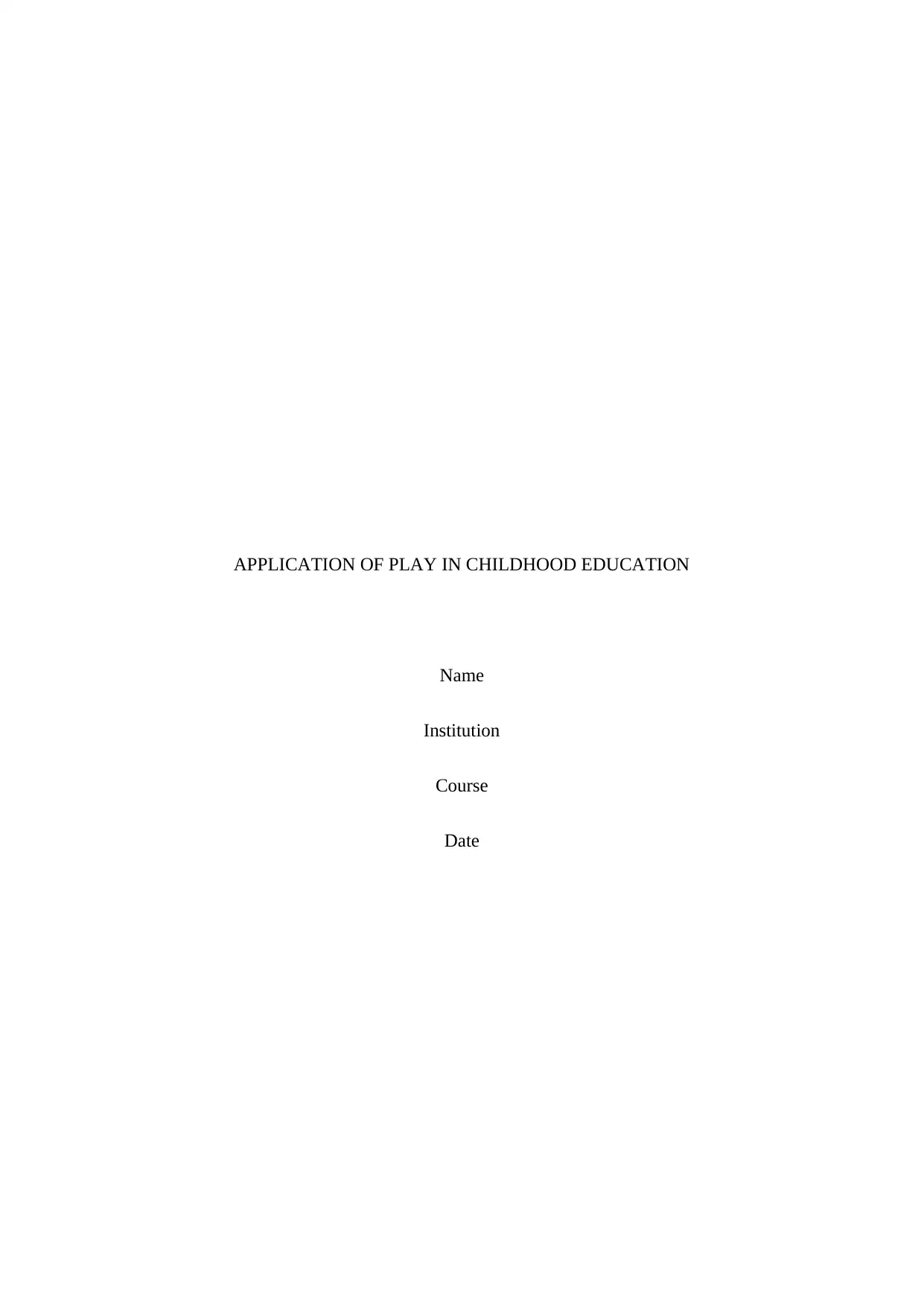
APPLICATION OF PLAY IN CHILDHOOD EDUCATION
Name
Institution
Course
Date
Name
Institution
Course
Date
Paraphrase This Document
Need a fresh take? Get an instant paraphrase of this document with our AI Paraphraser
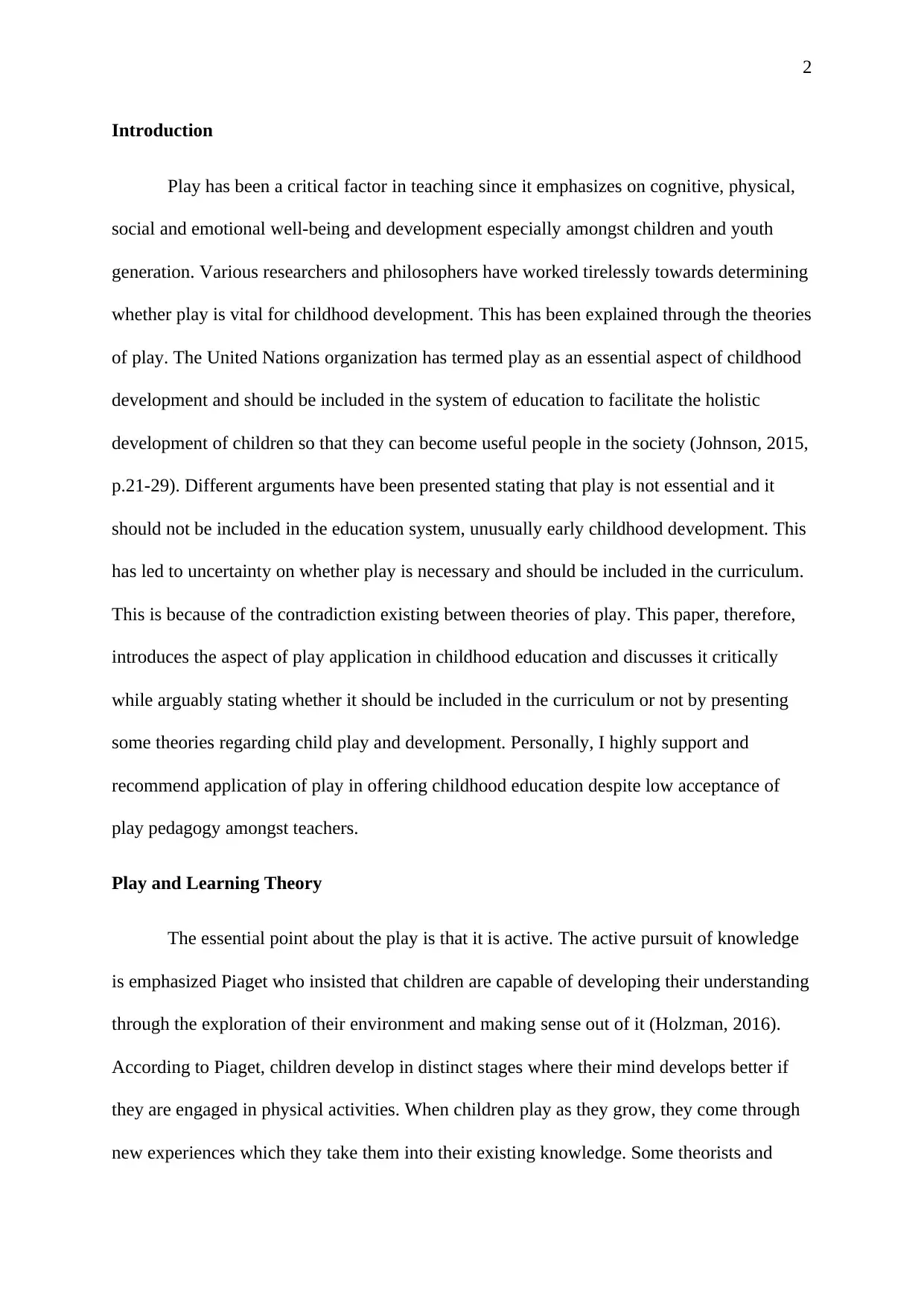
2
Introduction
Play has been a critical factor in teaching since it emphasizes on cognitive, physical,
social and emotional well-being and development especially amongst children and youth
generation. Various researchers and philosophers have worked tirelessly towards determining
whether play is vital for childhood development. This has been explained through the theories
of play. The United Nations organization has termed play as an essential aspect of childhood
development and should be included in the system of education to facilitate the holistic
development of children so that they can become useful people in the society (Johnson, 2015,
p.21-29). Different arguments have been presented stating that play is not essential and it
should not be included in the education system, unusually early childhood development. This
has led to uncertainty on whether play is necessary and should be included in the curriculum.
This is because of the contradiction existing between theories of play. This paper, therefore,
introduces the aspect of play application in childhood education and discusses it critically
while arguably stating whether it should be included in the curriculum or not by presenting
some theories regarding child play and development. Personally, I highly support and
recommend application of play in offering childhood education despite low acceptance of
play pedagogy amongst teachers.
Play and Learning Theory
The essential point about the play is that it is active. The active pursuit of knowledge
is emphasized Piaget who insisted that children are capable of developing their understanding
through the exploration of their environment and making sense out of it (Holzman, 2016).
According to Piaget, children develop in distinct stages where their mind develops better if
they are engaged in physical activities. When children play as they grow, they come through
new experiences which they take them into their existing knowledge. Some theorists and
Introduction
Play has been a critical factor in teaching since it emphasizes on cognitive, physical,
social and emotional well-being and development especially amongst children and youth
generation. Various researchers and philosophers have worked tirelessly towards determining
whether play is vital for childhood development. This has been explained through the theories
of play. The United Nations organization has termed play as an essential aspect of childhood
development and should be included in the system of education to facilitate the holistic
development of children so that they can become useful people in the society (Johnson, 2015,
p.21-29). Different arguments have been presented stating that play is not essential and it
should not be included in the education system, unusually early childhood development. This
has led to uncertainty on whether play is necessary and should be included in the curriculum.
This is because of the contradiction existing between theories of play. This paper, therefore,
introduces the aspect of play application in childhood education and discusses it critically
while arguably stating whether it should be included in the curriculum or not by presenting
some theories regarding child play and development. Personally, I highly support and
recommend application of play in offering childhood education despite low acceptance of
play pedagogy amongst teachers.
Play and Learning Theory
The essential point about the play is that it is active. The active pursuit of knowledge
is emphasized Piaget who insisted that children are capable of developing their understanding
through the exploration of their environment and making sense out of it (Holzman, 2016).
According to Piaget, children develop in distinct stages where their mind develops better if
they are engaged in physical activities. When children play as they grow, they come through
new experiences which they take them into their existing knowledge. Some theorists and
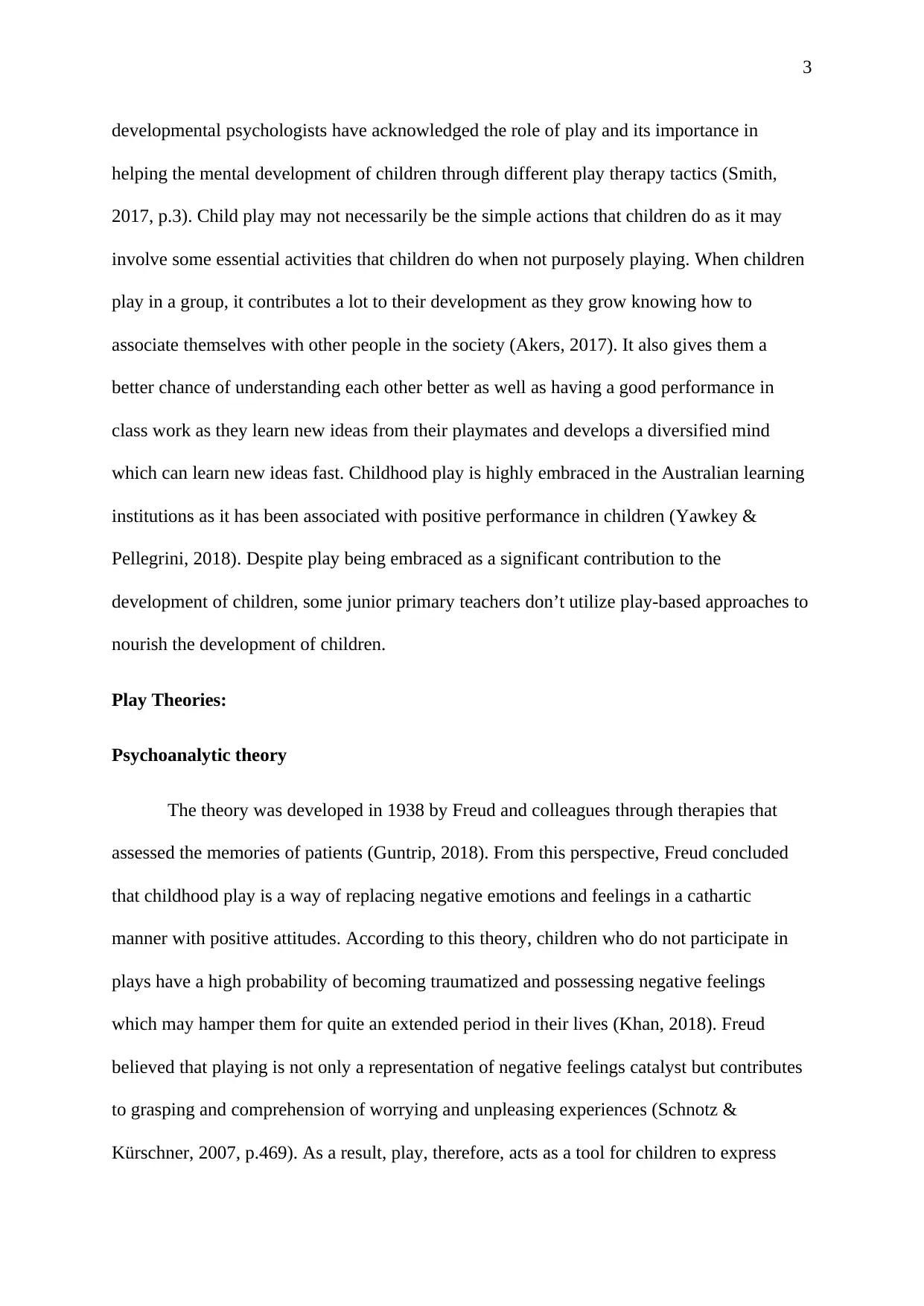
3
developmental psychologists have acknowledged the role of play and its importance in
helping the mental development of children through different play therapy tactics (Smith,
2017, p.3). Child play may not necessarily be the simple actions that children do as it may
involve some essential activities that children do when not purposely playing. When children
play in a group, it contributes a lot to their development as they grow knowing how to
associate themselves with other people in the society (Akers, 2017). It also gives them a
better chance of understanding each other better as well as having a good performance in
class work as they learn new ideas from their playmates and develops a diversified mind
which can learn new ideas fast. Childhood play is highly embraced in the Australian learning
institutions as it has been associated with positive performance in children (Yawkey &
Pellegrini, 2018). Despite play being embraced as a significant contribution to the
development of children, some junior primary teachers don’t utilize play-based approaches to
nourish the development of children.
Play Theories:
Psychoanalytic theory
The theory was developed in 1938 by Freud and colleagues through therapies that
assessed the memories of patients (Guntrip, 2018). From this perspective, Freud concluded
that childhood play is a way of replacing negative emotions and feelings in a cathartic
manner with positive attitudes. According to this theory, children who do not participate in
plays have a high probability of becoming traumatized and possessing negative feelings
which may hamper them for quite an extended period in their lives (Khan, 2018). Freud
believed that playing is not only a representation of negative feelings catalyst but contributes
to grasping and comprehension of worrying and unpleasing experiences (Schnotz &
Kürschner, 2007, p.469). As a result, play, therefore, acts as a tool for children to express
developmental psychologists have acknowledged the role of play and its importance in
helping the mental development of children through different play therapy tactics (Smith,
2017, p.3). Child play may not necessarily be the simple actions that children do as it may
involve some essential activities that children do when not purposely playing. When children
play in a group, it contributes a lot to their development as they grow knowing how to
associate themselves with other people in the society (Akers, 2017). It also gives them a
better chance of understanding each other better as well as having a good performance in
class work as they learn new ideas from their playmates and develops a diversified mind
which can learn new ideas fast. Childhood play is highly embraced in the Australian learning
institutions as it has been associated with positive performance in children (Yawkey &
Pellegrini, 2018). Despite play being embraced as a significant contribution to the
development of children, some junior primary teachers don’t utilize play-based approaches to
nourish the development of children.
Play Theories:
Psychoanalytic theory
The theory was developed in 1938 by Freud and colleagues through therapies that
assessed the memories of patients (Guntrip, 2018). From this perspective, Freud concluded
that childhood play is a way of replacing negative emotions and feelings in a cathartic
manner with positive attitudes. According to this theory, children who do not participate in
plays have a high probability of becoming traumatized and possessing negative feelings
which may hamper them for quite an extended period in their lives (Khan, 2018). Freud
believed that playing is not only a representation of negative feelings catalyst but contributes
to grasping and comprehension of worrying and unpleasing experiences (Schnotz &
Kürschner, 2007, p.469). As a result, play, therefore, acts as a tool for children to express
⊘ This is a preview!⊘
Do you want full access?
Subscribe today to unlock all pages.

Trusted by 1+ million students worldwide
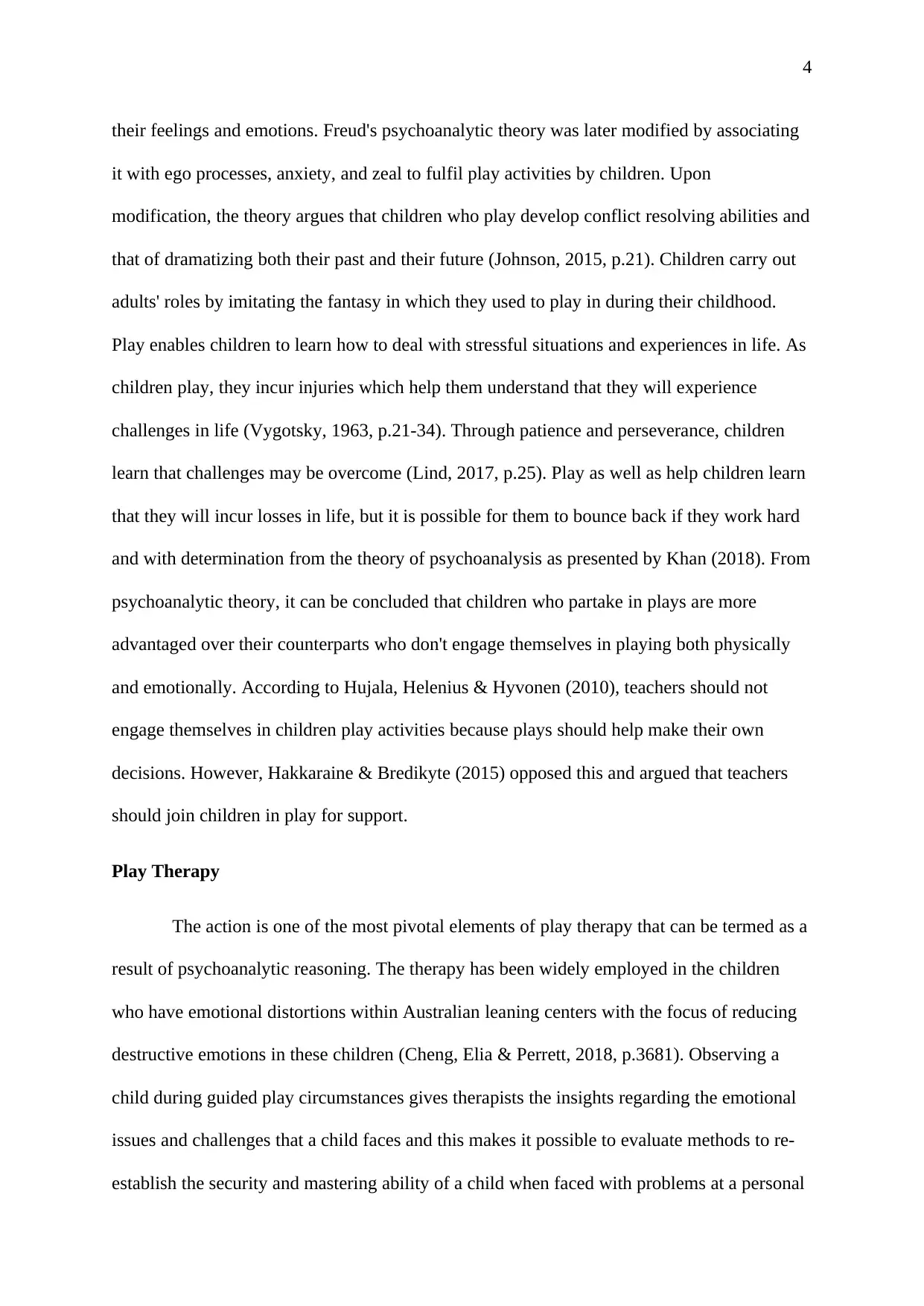
4
their feelings and emotions. Freud's psychoanalytic theory was later modified by associating
it with ego processes, anxiety, and zeal to fulfil play activities by children. Upon
modification, the theory argues that children who play develop conflict resolving abilities and
that of dramatizing both their past and their future (Johnson, 2015, p.21). Children carry out
adults' roles by imitating the fantasy in which they used to play in during their childhood.
Play enables children to learn how to deal with stressful situations and experiences in life. As
children play, they incur injuries which help them understand that they will experience
challenges in life (Vygotsky, 1963, p.21-34). Through patience and perseverance, children
learn that challenges may be overcome (Lind, 2017, p.25). Play as well as help children learn
that they will incur losses in life, but it is possible for them to bounce back if they work hard
and with determination from the theory of psychoanalysis as presented by Khan (2018). From
psychoanalytic theory, it can be concluded that children who partake in plays are more
advantaged over their counterparts who don't engage themselves in playing both physically
and emotionally. According to Hujala, Helenius & Hyvonen (2010), teachers should not
engage themselves in children play activities because plays should help make their own
decisions. However, Hakkaraine & Bredikyte (2015) opposed this and argued that teachers
should join children in play for support.
Play Therapy
The action is one of the most pivotal elements of play therapy that can be termed as a
result of psychoanalytic reasoning. The therapy has been widely employed in the children
who have emotional distortions within Australian leaning centers with the focus of reducing
destructive emotions in these children (Cheng, Elia & Perrett, 2018, p.3681). Observing a
child during guided play circumstances gives therapists the insights regarding the emotional
issues and challenges that a child faces and this makes it possible to evaluate methods to re-
establish the security and mastering ability of a child when faced with problems at a personal
their feelings and emotions. Freud's psychoanalytic theory was later modified by associating
it with ego processes, anxiety, and zeal to fulfil play activities by children. Upon
modification, the theory argues that children who play develop conflict resolving abilities and
that of dramatizing both their past and their future (Johnson, 2015, p.21). Children carry out
adults' roles by imitating the fantasy in which they used to play in during their childhood.
Play enables children to learn how to deal with stressful situations and experiences in life. As
children play, they incur injuries which help them understand that they will experience
challenges in life (Vygotsky, 1963, p.21-34). Through patience and perseverance, children
learn that challenges may be overcome (Lind, 2017, p.25). Play as well as help children learn
that they will incur losses in life, but it is possible for them to bounce back if they work hard
and with determination from the theory of psychoanalysis as presented by Khan (2018). From
psychoanalytic theory, it can be concluded that children who partake in plays are more
advantaged over their counterparts who don't engage themselves in playing both physically
and emotionally. According to Hujala, Helenius & Hyvonen (2010), teachers should not
engage themselves in children play activities because plays should help make their own
decisions. However, Hakkaraine & Bredikyte (2015) opposed this and argued that teachers
should join children in play for support.
Play Therapy
The action is one of the most pivotal elements of play therapy that can be termed as a
result of psychoanalytic reasoning. The therapy has been widely employed in the children
who have emotional distortions within Australian leaning centers with the focus of reducing
destructive emotions in these children (Cheng, Elia & Perrett, 2018, p.3681). Observing a
child during guided play circumstances gives therapists the insights regarding the emotional
issues and challenges that a child faces and this makes it possible to evaluate methods to re-
establish the security and mastering ability of a child when faced with problems at a personal
Paraphrase This Document
Need a fresh take? Get an instant paraphrase of this document with our AI Paraphraser

5
situation (Taylor, 2017, p.17). Some teachers find it hard to engage in child plays and thus
disregard the use of the play pedagogy in the teaching of junior pupils. Others associate play
with the division of children’s attention in class thus constituting to poor performance in their
studies.
Cognitive Theories
The most arguments on cognitive theories were put forward by Piaget and Vygotsky.
The two tried to understand the precise association between cognitive developments and play
habits in children. One has to have an in-depth understanding of the ideas brought by Piaget
on cognitive development theory where both assimilation and accommodation are most vital
and present factors (Hakkarainen, 2006, p.183). According to Piaget & Elkind (1968),
assimilation is built on the ability and process of a child to adjust and integrate external
content from the world outside of the existing mental understanding. Children develop the
capability to attain a balanced cognitive potential of many surround structures (Howard &
Mclnnes, 2010). This is the reason why children like playing since they don't require to adapt
their cognitive patterns to the world when they play more. The world, in turn, accommodates
the universe in which children play following their rules. A child goes through changing
stages in a sequence where they learn different things at each step (Vygotsky, 1963, p.21-34).
Vygotsky had a firm belief that child play facilitates and speeds the cognitive
development in children. His approach was not too different from that of Piaget, but it was to
that of Freud who focused more on cases of traumatized children (Vygotsky, 1963, p.21-34).
As a result, his ideas were not in line with those of many other theorists. Vygotsky argued
that play is always ahead of a child head and everyday behavior. The more a child plays, the
more their mental capability increases. Children develop the ability to make distinctive
decisions between cognitive and physical actions thus improving the power to choose
situation (Taylor, 2017, p.17). Some teachers find it hard to engage in child plays and thus
disregard the use of the play pedagogy in the teaching of junior pupils. Others associate play
with the division of children’s attention in class thus constituting to poor performance in their
studies.
Cognitive Theories
The most arguments on cognitive theories were put forward by Piaget and Vygotsky.
The two tried to understand the precise association between cognitive developments and play
habits in children. One has to have an in-depth understanding of the ideas brought by Piaget
on cognitive development theory where both assimilation and accommodation are most vital
and present factors (Hakkarainen, 2006, p.183). According to Piaget & Elkind (1968),
assimilation is built on the ability and process of a child to adjust and integrate external
content from the world outside of the existing mental understanding. Children develop the
capability to attain a balanced cognitive potential of many surround structures (Howard &
Mclnnes, 2010). This is the reason why children like playing since they don't require to adapt
their cognitive patterns to the world when they play more. The world, in turn, accommodates
the universe in which children play following their rules. A child goes through changing
stages in a sequence where they learn different things at each step (Vygotsky, 1963, p.21-34).
Vygotsky had a firm belief that child play facilitates and speeds the cognitive
development in children. His approach was not too different from that of Piaget, but it was to
that of Freud who focused more on cases of traumatized children (Vygotsky, 1963, p.21-34).
As a result, his ideas were not in line with those of many other theorists. Vygotsky argued
that play is always ahead of a child head and everyday behavior. The more a child plays, the
more their mental capability increases. Children develop the ability to make distinctive
decisions between cognitive and physical actions thus improving the power to choose
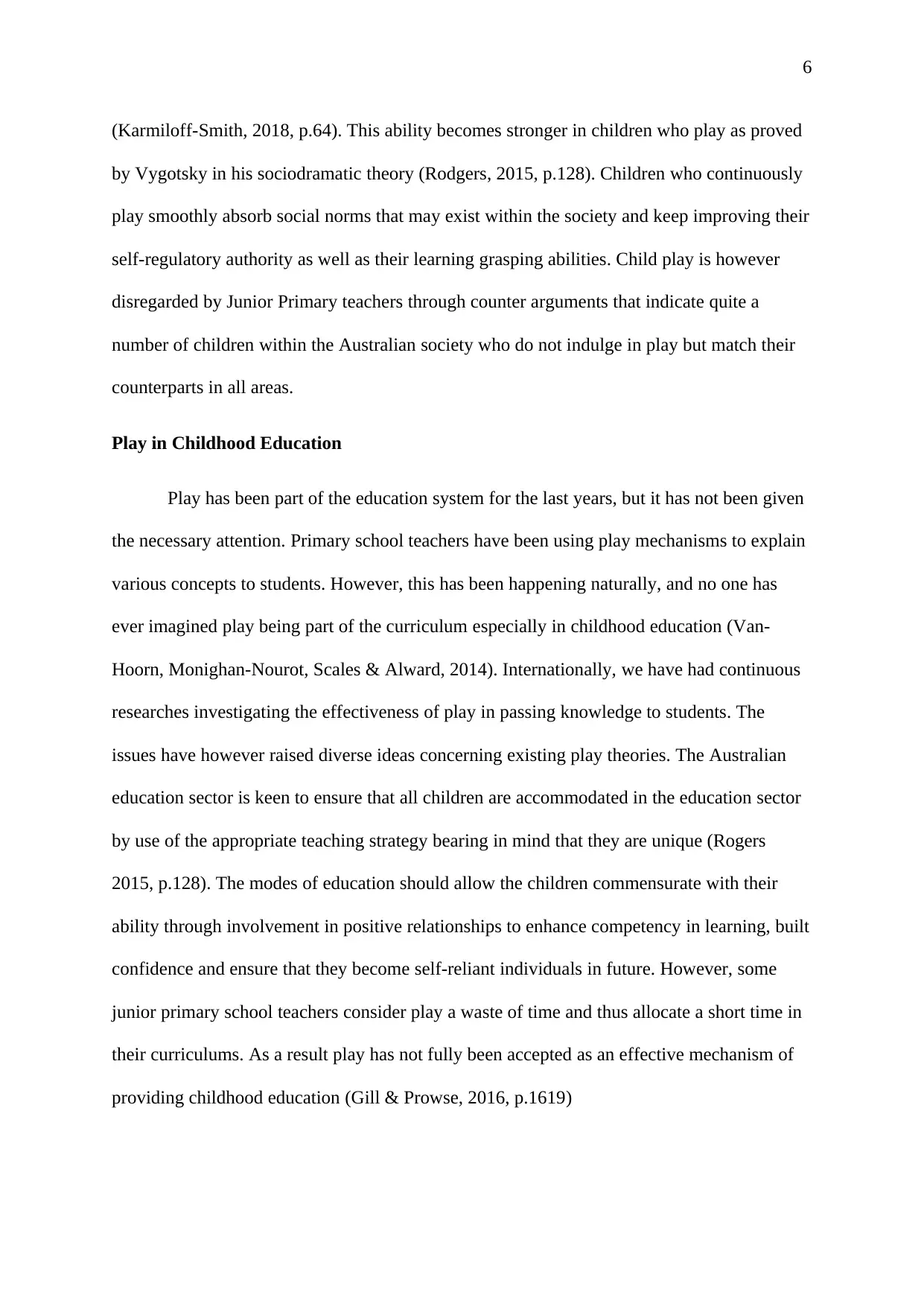
6
(Karmiloff-Smith, 2018, p.64). This ability becomes stronger in children who play as proved
by Vygotsky in his sociodramatic theory (Rodgers, 2015, p.128). Children who continuously
play smoothly absorb social norms that may exist within the society and keep improving their
self-regulatory authority as well as their learning grasping abilities. Child play is however
disregarded by Junior Primary teachers through counter arguments that indicate quite a
number of children within the Australian society who do not indulge in play but match their
counterparts in all areas.
Play in Childhood Education
Play has been part of the education system for the last years, but it has not been given
the necessary attention. Primary school teachers have been using play mechanisms to explain
various concepts to students. However, this has been happening naturally, and no one has
ever imagined play being part of the curriculum especially in childhood education (Van-
Hoorn, Monighan-Nourot, Scales & Alward, 2014). Internationally, we have had continuous
researches investigating the effectiveness of play in passing knowledge to students. The
issues have however raised diverse ideas concerning existing play theories. The Australian
education sector is keen to ensure that all children are accommodated in the education sector
by use of the appropriate teaching strategy bearing in mind that they are unique (Rogers
2015, p.128). The modes of education should allow the children commensurate with their
ability through involvement in positive relationships to enhance competency in learning, built
confidence and ensure that they become self-reliant individuals in future. However, some
junior primary school teachers consider play a waste of time and thus allocate a short time in
their curriculums. As a result play has not fully been accepted as an effective mechanism of
providing childhood education (Gill & Prowse, 2016, p.1619)
(Karmiloff-Smith, 2018, p.64). This ability becomes stronger in children who play as proved
by Vygotsky in his sociodramatic theory (Rodgers, 2015, p.128). Children who continuously
play smoothly absorb social norms that may exist within the society and keep improving their
self-regulatory authority as well as their learning grasping abilities. Child play is however
disregarded by Junior Primary teachers through counter arguments that indicate quite a
number of children within the Australian society who do not indulge in play but match their
counterparts in all areas.
Play in Childhood Education
Play has been part of the education system for the last years, but it has not been given
the necessary attention. Primary school teachers have been using play mechanisms to explain
various concepts to students. However, this has been happening naturally, and no one has
ever imagined play being part of the curriculum especially in childhood education (Van-
Hoorn, Monighan-Nourot, Scales & Alward, 2014). Internationally, we have had continuous
researches investigating the effectiveness of play in passing knowledge to students. The
issues have however raised diverse ideas concerning existing play theories. The Australian
education sector is keen to ensure that all children are accommodated in the education sector
by use of the appropriate teaching strategy bearing in mind that they are unique (Rogers
2015, p.128). The modes of education should allow the children commensurate with their
ability through involvement in positive relationships to enhance competency in learning, built
confidence and ensure that they become self-reliant individuals in future. However, some
junior primary school teachers consider play a waste of time and thus allocate a short time in
their curriculums. As a result play has not fully been accepted as an effective mechanism of
providing childhood education (Gill & Prowse, 2016, p.1619)
⊘ This is a preview!⊘
Do you want full access?
Subscribe today to unlock all pages.

Trusted by 1+ million students worldwide
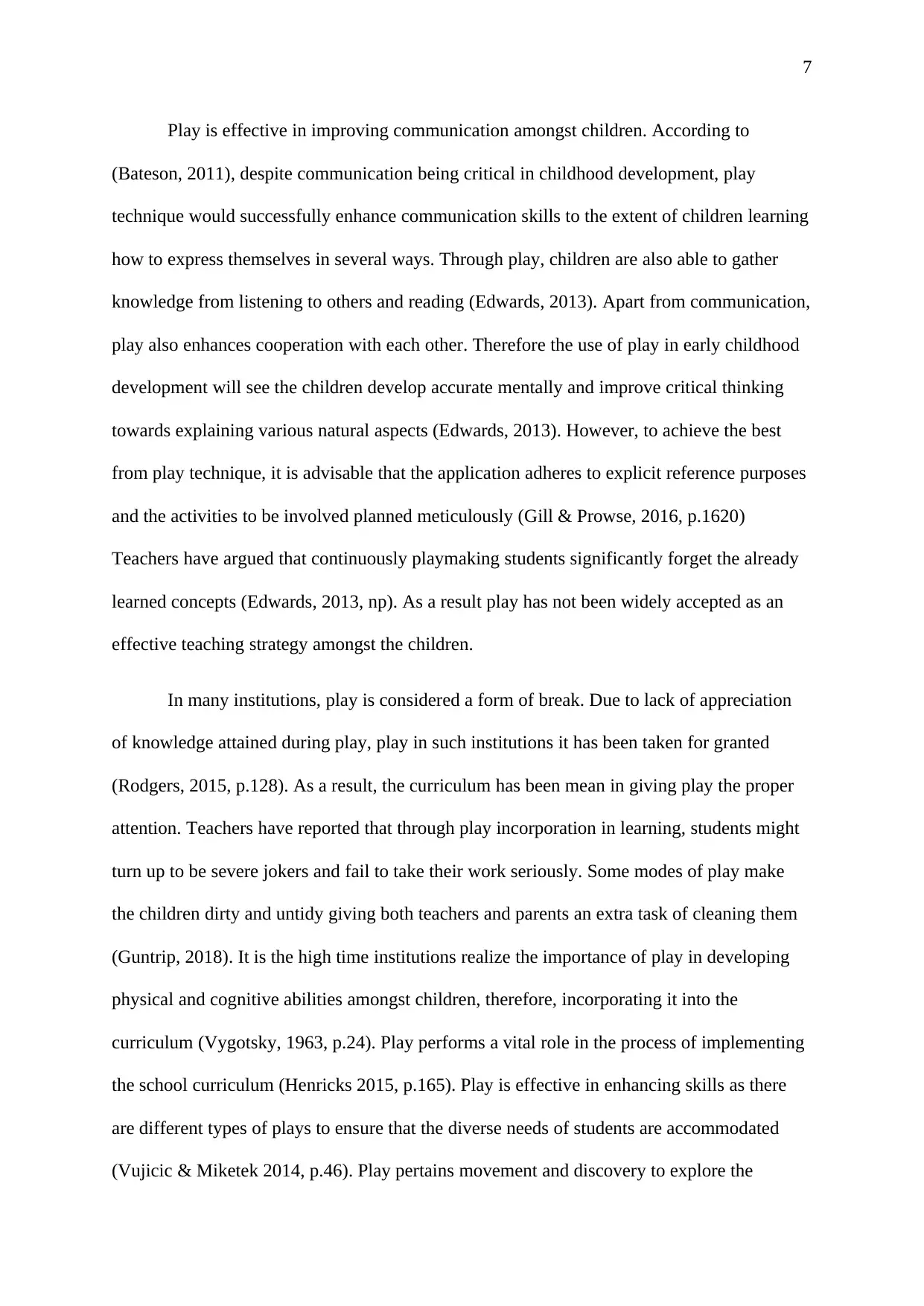
7
Play is effective in improving communication amongst children. According to
(Bateson, 2011), despite communication being critical in childhood development, play
technique would successfully enhance communication skills to the extent of children learning
how to express themselves in several ways. Through play, children are also able to gather
knowledge from listening to others and reading (Edwards, 2013). Apart from communication,
play also enhances cooperation with each other. Therefore the use of play in early childhood
development will see the children develop accurate mentally and improve critical thinking
towards explaining various natural aspects (Edwards, 2013). However, to achieve the best
from play technique, it is advisable that the application adheres to explicit reference purposes
and the activities to be involved planned meticulously (Gill & Prowse, 2016, p.1620)
Teachers have argued that continuously playmaking students significantly forget the already
learned concepts (Edwards, 2013, np). As a result play has not been widely accepted as an
effective teaching strategy amongst the children.
In many institutions, play is considered a form of break. Due to lack of appreciation
of knowledge attained during play, play in such institutions it has been taken for granted
(Rodgers, 2015, p.128). As a result, the curriculum has been mean in giving play the proper
attention. Teachers have reported that through play incorporation in learning, students might
turn up to be severe jokers and fail to take their work seriously. Some modes of play make
the children dirty and untidy giving both teachers and parents an extra task of cleaning them
(Guntrip, 2018). It is the high time institutions realize the importance of play in developing
physical and cognitive abilities amongst children, therefore, incorporating it into the
curriculum (Vygotsky, 1963, p.24). Play performs a vital role in the process of implementing
the school curriculum (Henricks 2015, p.165). Play is effective in enhancing skills as there
are different types of plays to ensure that the diverse needs of students are accommodated
(Vujicic & Miketek 2014, p.46). Play pertains movement and discovery to explore the
Play is effective in improving communication amongst children. According to
(Bateson, 2011), despite communication being critical in childhood development, play
technique would successfully enhance communication skills to the extent of children learning
how to express themselves in several ways. Through play, children are also able to gather
knowledge from listening to others and reading (Edwards, 2013). Apart from communication,
play also enhances cooperation with each other. Therefore the use of play in early childhood
development will see the children develop accurate mentally and improve critical thinking
towards explaining various natural aspects (Edwards, 2013). However, to achieve the best
from play technique, it is advisable that the application adheres to explicit reference purposes
and the activities to be involved planned meticulously (Gill & Prowse, 2016, p.1620)
Teachers have argued that continuously playmaking students significantly forget the already
learned concepts (Edwards, 2013, np). As a result play has not been widely accepted as an
effective teaching strategy amongst the children.
In many institutions, play is considered a form of break. Due to lack of appreciation
of knowledge attained during play, play in such institutions it has been taken for granted
(Rodgers, 2015, p.128). As a result, the curriculum has been mean in giving play the proper
attention. Teachers have reported that through play incorporation in learning, students might
turn up to be severe jokers and fail to take their work seriously. Some modes of play make
the children dirty and untidy giving both teachers and parents an extra task of cleaning them
(Guntrip, 2018). It is the high time institutions realize the importance of play in developing
physical and cognitive abilities amongst children, therefore, incorporating it into the
curriculum (Vygotsky, 1963, p.24). Play performs a vital role in the process of implementing
the school curriculum (Henricks 2015, p.165). Play is effective in enhancing skills as there
are different types of plays to ensure that the diverse needs of students are accommodated
(Vujicic & Miketek 2014, p.46). Play pertains movement and discovery to explore the
Paraphrase This Document
Need a fresh take? Get an instant paraphrase of this document with our AI Paraphraser

8
environment as well as the use of language (Edwards, 2013). The multipurpose nature of play
also enables students to practice future skills once utilized as a teaching technique. It allows
people to solve problems quickly by communicating effectively with others (Henricks 2015,
p.164). Children exposure plays a significant role in their development. Play exposes children
to a diverse environment, therefore, enhancing their growth (Roger 2015, p.129). However,
children must feel safe and free so that they can play in a relaxed manner. The feeling
strengthens their emotions and prepares them to learn efficiently. To enhance safety during
play, practitioners should build experiences within home environment since it makes them
have an opportunity of progression and extension to through the existing challenges (Bateson,
2011). Play is used as a teaching technique which is critical to the learning process as it
involves careful designing of activities which take advantage of children innate ability to
enjoy (Edwards, 2013).
Play is a useful learning theory since it incorporates children bodies, minds and
emotions. Its effectiveness enables it to enhance childhood development (Taylor, 2017, p.17).
Children are in a position of developing favorable attitudes towards learning since it expands
children interests and enables them to remain active during the entire learning period
(Bateson, 2011). It involves creativity and a lot of experiments allowing children to think
critically towards solving various life problems. It also attracts resilience and the ability to
work alongside others as part of the educative process (Edwards, 2013). The most critical
aspect of play dictating as to why it should be adopted in teaching children it is the fact that it
is active. Activeness is necessary for emphasizing children ability to construct their
knowledge as individuals through exploring their environment (Henricks 2015, p.164). Play
highly underlines cognitive skills and dramatically enhances childhood development (Nath &
Szucs, 2014, p.73). As a result, children are in a position of gaining sufficient knowledge due
to the process of discovery associated with play mode of teaching. Children are therefore
environment as well as the use of language (Edwards, 2013). The multipurpose nature of play
also enables students to practice future skills once utilized as a teaching technique. It allows
people to solve problems quickly by communicating effectively with others (Henricks 2015,
p.164). Children exposure plays a significant role in their development. Play exposes children
to a diverse environment, therefore, enhancing their growth (Roger 2015, p.129). However,
children must feel safe and free so that they can play in a relaxed manner. The feeling
strengthens their emotions and prepares them to learn efficiently. To enhance safety during
play, practitioners should build experiences within home environment since it makes them
have an opportunity of progression and extension to through the existing challenges (Bateson,
2011). Play is used as a teaching technique which is critical to the learning process as it
involves careful designing of activities which take advantage of children innate ability to
enjoy (Edwards, 2013).
Play is a useful learning theory since it incorporates children bodies, minds and
emotions. Its effectiveness enables it to enhance childhood development (Taylor, 2017, p.17).
Children are in a position of developing favorable attitudes towards learning since it expands
children interests and enables them to remain active during the entire learning period
(Bateson, 2011). It involves creativity and a lot of experiments allowing children to think
critically towards solving various life problems. It also attracts resilience and the ability to
work alongside others as part of the educative process (Edwards, 2013). The most critical
aspect of play dictating as to why it should be adopted in teaching children it is the fact that it
is active. Activeness is necessary for emphasizing children ability to construct their
knowledge as individuals through exploring their environment (Henricks 2015, p.164). Play
highly underlines cognitive skills and dramatically enhances childhood development (Nath &
Szucs, 2014, p.73). As a result, children are in a position of gaining sufficient knowledge due
to the process of discovery associated with play mode of teaching. Children are therefore
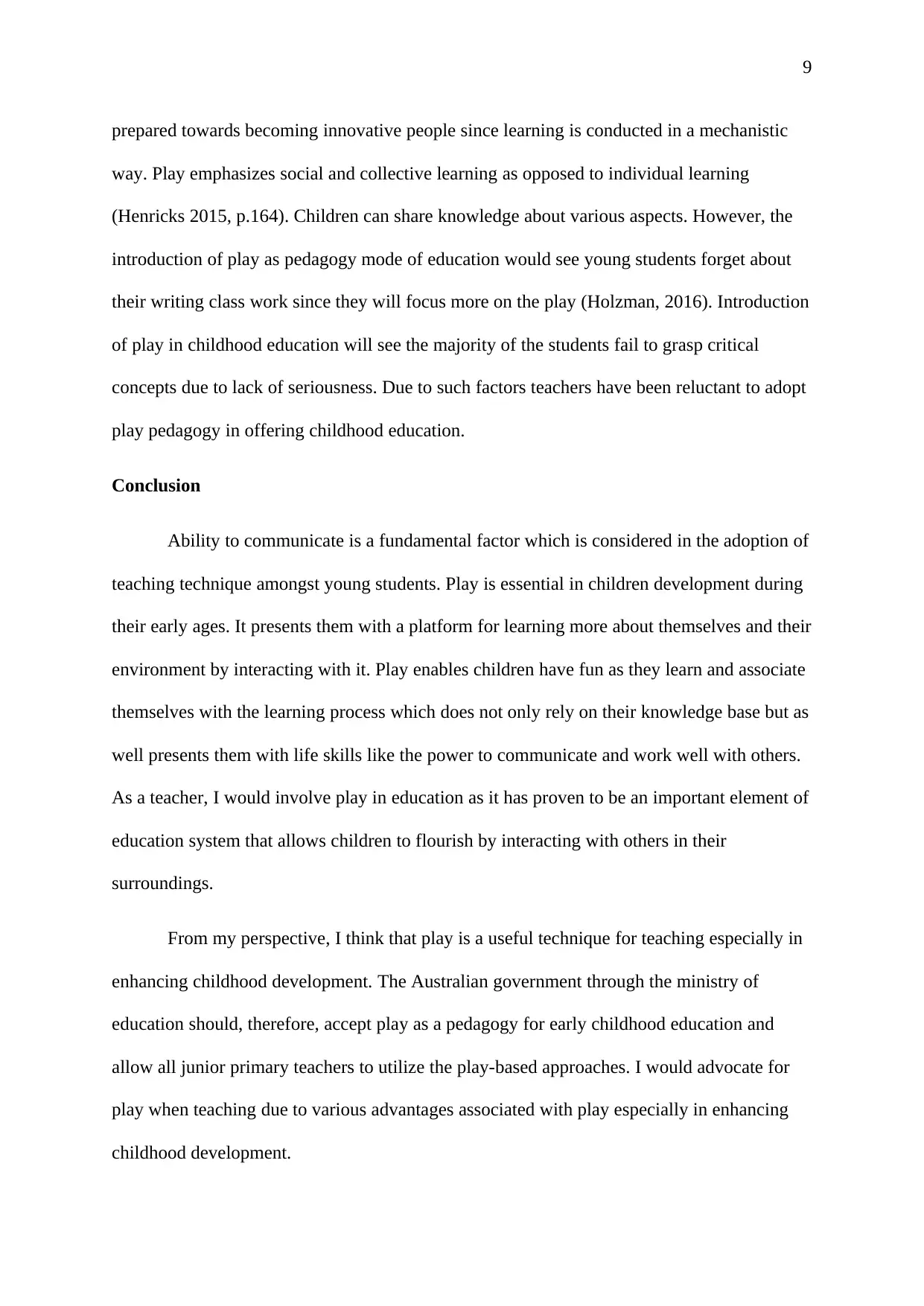
9
prepared towards becoming innovative people since learning is conducted in a mechanistic
way. Play emphasizes social and collective learning as opposed to individual learning
(Henricks 2015, p.164). Children can share knowledge about various aspects. However, the
introduction of play as pedagogy mode of education would see young students forget about
their writing class work since they will focus more on the play (Holzman, 2016). Introduction
of play in childhood education will see the majority of the students fail to grasp critical
concepts due to lack of seriousness. Due to such factors teachers have been reluctant to adopt
play pedagogy in offering childhood education.
Conclusion
Ability to communicate is a fundamental factor which is considered in the adoption of
teaching technique amongst young students. Play is essential in children development during
their early ages. It presents them with a platform for learning more about themselves and their
environment by interacting with it. Play enables children have fun as they learn and associate
themselves with the learning process which does not only rely on their knowledge base but as
well presents them with life skills like the power to communicate and work well with others.
As a teacher, I would involve play in education as it has proven to be an important element of
education system that allows children to flourish by interacting with others in their
surroundings.
From my perspective, I think that play is a useful technique for teaching especially in
enhancing childhood development. The Australian government through the ministry of
education should, therefore, accept play as a pedagogy for early childhood education and
allow all junior primary teachers to utilize the play-based approaches. I would advocate for
play when teaching due to various advantages associated with play especially in enhancing
childhood development.
prepared towards becoming innovative people since learning is conducted in a mechanistic
way. Play emphasizes social and collective learning as opposed to individual learning
(Henricks 2015, p.164). Children can share knowledge about various aspects. However, the
introduction of play as pedagogy mode of education would see young students forget about
their writing class work since they will focus more on the play (Holzman, 2016). Introduction
of play in childhood education will see the majority of the students fail to grasp critical
concepts due to lack of seriousness. Due to such factors teachers have been reluctant to adopt
play pedagogy in offering childhood education.
Conclusion
Ability to communicate is a fundamental factor which is considered in the adoption of
teaching technique amongst young students. Play is essential in children development during
their early ages. It presents them with a platform for learning more about themselves and their
environment by interacting with it. Play enables children have fun as they learn and associate
themselves with the learning process which does not only rely on their knowledge base but as
well presents them with life skills like the power to communicate and work well with others.
As a teacher, I would involve play in education as it has proven to be an important element of
education system that allows children to flourish by interacting with others in their
surroundings.
From my perspective, I think that play is a useful technique for teaching especially in
enhancing childhood development. The Australian government through the ministry of
education should, therefore, accept play as a pedagogy for early childhood education and
allow all junior primary teachers to utilize the play-based approaches. I would advocate for
play when teaching due to various advantages associated with play especially in enhancing
childhood development.
⊘ This is a preview!⊘
Do you want full access?
Subscribe today to unlock all pages.

Trusted by 1+ million students worldwide

10
Bibliography
Bibliography
Paraphrase This Document
Need a fresh take? Get an instant paraphrase of this document with our AI Paraphraser

11
Akers, R., 2017. Social learning and social structure: A general theory of crime and deviance.
Routledge.
Bateson, P., 2011. Theories of play. In The Oxford handbook of the development of play.
Cheng, D.R., Elia, S. and Perrett, K.P., 2018. Immunizations under sedation at a paediatric
hospital in Melbourne, Australia from 2012–2016. Vaccine, 36(25), pp.3681-3685.
Edwards, B., 2013. Theories of play and postmodern fiction. Routledge.
Gill, D., & Prowse, V. (2016). Cognitive ability, character skills, and learning to play
equilibrium: A level-k analysis. Journal of Political Economy, 124(6), 1619-1676.
Guntrip, H. (2018). Psychoanalytic theory, therapy and the self. Routledge.
Hakkarainen, P., 2006. Learning and development in play. Nordic childhoods and early
education, pp.183-222.
Henricks, T.S., 2015. Classic theories of play (Vol. 1, pp. 163-179). New York: Rowman &
Littlefield.
Holzman, L., 2016. Vygotsky at work and play. Routledge.
Howard, J. and McInnes, K., 2010. Thinking through the challenge of a play-based
curriculum: Increasing playfulness via co-construction.
Johnson, J. E. 2015. Play development from ages four to eight years. Play from birth to
twelve, 21-29.
Karmiloff-Smith, A., 2018. Précis of Beyond modularity: A developmental perspective on
cognitive science. In Thinking Developmentally from Constructivism to
Neuroconstructivism (pp. 64-94). Routledge.
Khan, M., 2018. Hidden selves: Between theory and practice in psychoanalysis. Routledge.
Akers, R., 2017. Social learning and social structure: A general theory of crime and deviance.
Routledge.
Bateson, P., 2011. Theories of play. In The Oxford handbook of the development of play.
Cheng, D.R., Elia, S. and Perrett, K.P., 2018. Immunizations under sedation at a paediatric
hospital in Melbourne, Australia from 2012–2016. Vaccine, 36(25), pp.3681-3685.
Edwards, B., 2013. Theories of play and postmodern fiction. Routledge.
Gill, D., & Prowse, V. (2016). Cognitive ability, character skills, and learning to play
equilibrium: A level-k analysis. Journal of Political Economy, 124(6), 1619-1676.
Guntrip, H. (2018). Psychoanalytic theory, therapy and the self. Routledge.
Hakkarainen, P., 2006. Learning and development in play. Nordic childhoods and early
education, pp.183-222.
Henricks, T.S., 2015. Classic theories of play (Vol. 1, pp. 163-179). New York: Rowman &
Littlefield.
Holzman, L., 2016. Vygotsky at work and play. Routledge.
Howard, J. and McInnes, K., 2010. Thinking through the challenge of a play-based
curriculum: Increasing playfulness via co-construction.
Johnson, J. E. 2015. Play development from ages four to eight years. Play from birth to
twelve, 21-29.
Karmiloff-Smith, A., 2018. Précis of Beyond modularity: A developmental perspective on
cognitive science. In Thinking Developmentally from Constructivism to
Neuroconstructivism (pp. 64-94). Routledge.
Khan, M., 2018. Hidden selves: Between theory and practice in psychoanalysis. Routledge.
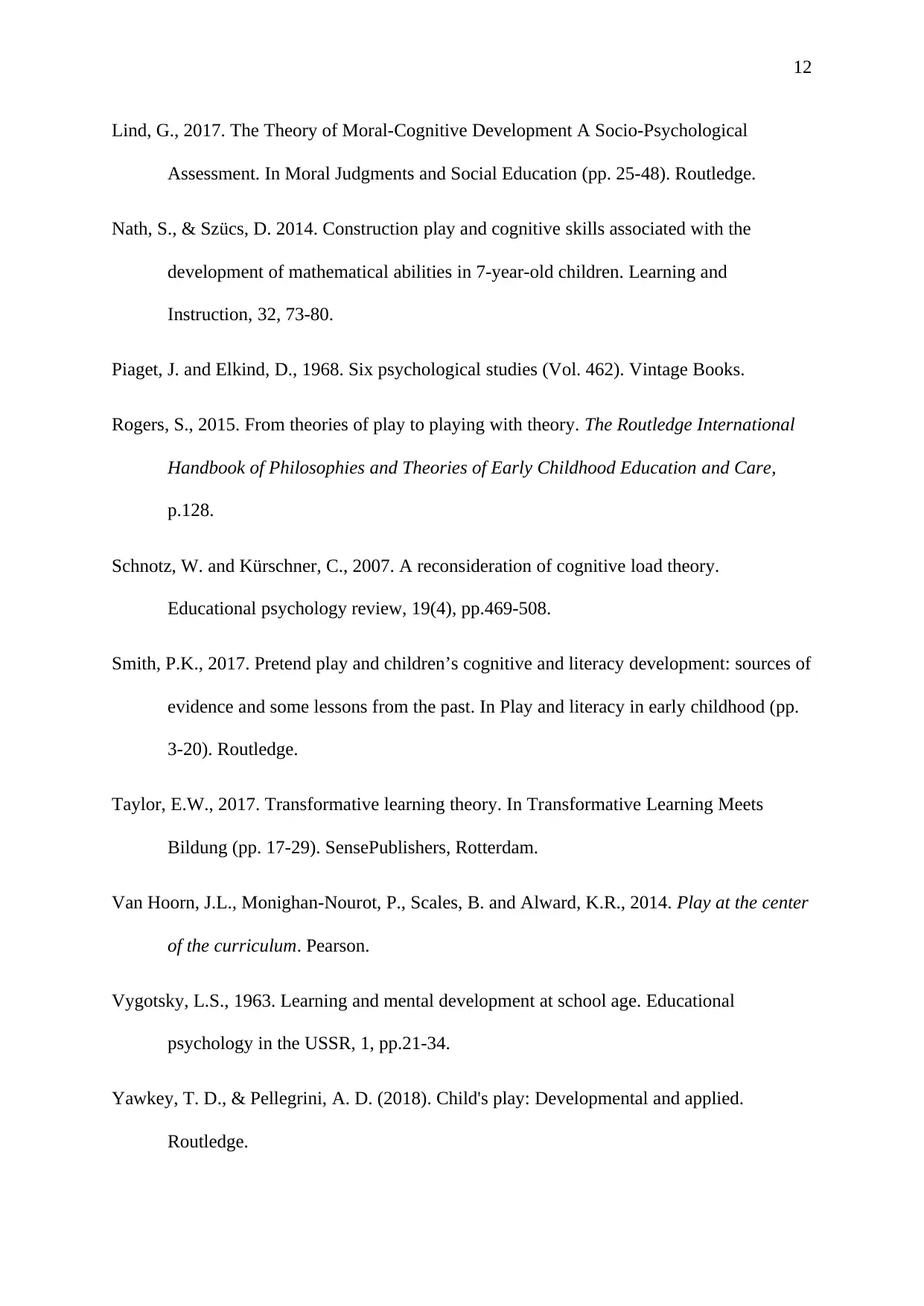
12
Lind, G., 2017. The Theory of Moral-Cognitive Development A Socio-Psychological
Assessment. In Moral Judgments and Social Education (pp. 25-48). Routledge.
Nath, S., & Szücs, D. 2014. Construction play and cognitive skills associated with the
development of mathematical abilities in 7-year-old children. Learning and
Instruction, 32, 73-80.
Piaget, J. and Elkind, D., 1968. Six psychological studies (Vol. 462). Vintage Books.
Rogers, S., 2015. From theories of play to playing with theory. The Routledge International
Handbook of Philosophies and Theories of Early Childhood Education and Care,
p.128.
Schnotz, W. and Kürschner, C., 2007. A reconsideration of cognitive load theory.
Educational psychology review, 19(4), pp.469-508.
Smith, P.K., 2017. Pretend play and children’s cognitive and literacy development: sources of
evidence and some lessons from the past. In Play and literacy in early childhood (pp.
3-20). Routledge.
Taylor, E.W., 2017. Transformative learning theory. In Transformative Learning Meets
Bildung (pp. 17-29). SensePublishers, Rotterdam.
Van Hoorn, J.L., Monighan-Nourot, P., Scales, B. and Alward, K.R., 2014. Play at the center
of the curriculum. Pearson.
Vygotsky, L.S., 1963. Learning and mental development at school age. Educational
psychology in the USSR, 1, pp.21-34.
Yawkey, T. D., & Pellegrini, A. D. (2018). Child's play: Developmental and applied.
Routledge.
Lind, G., 2017. The Theory of Moral-Cognitive Development A Socio-Psychological
Assessment. In Moral Judgments and Social Education (pp. 25-48). Routledge.
Nath, S., & Szücs, D. 2014. Construction play and cognitive skills associated with the
development of mathematical abilities in 7-year-old children. Learning and
Instruction, 32, 73-80.
Piaget, J. and Elkind, D., 1968. Six psychological studies (Vol. 462). Vintage Books.
Rogers, S., 2015. From theories of play to playing with theory. The Routledge International
Handbook of Philosophies and Theories of Early Childhood Education and Care,
p.128.
Schnotz, W. and Kürschner, C., 2007. A reconsideration of cognitive load theory.
Educational psychology review, 19(4), pp.469-508.
Smith, P.K., 2017. Pretend play and children’s cognitive and literacy development: sources of
evidence and some lessons from the past. In Play and literacy in early childhood (pp.
3-20). Routledge.
Taylor, E.W., 2017. Transformative learning theory. In Transformative Learning Meets
Bildung (pp. 17-29). SensePublishers, Rotterdam.
Van Hoorn, J.L., Monighan-Nourot, P., Scales, B. and Alward, K.R., 2014. Play at the center
of the curriculum. Pearson.
Vygotsky, L.S., 1963. Learning and mental development at school age. Educational
psychology in the USSR, 1, pp.21-34.
Yawkey, T. D., & Pellegrini, A. D. (2018). Child's play: Developmental and applied.
Routledge.
⊘ This is a preview!⊘
Do you want full access?
Subscribe today to unlock all pages.

Trusted by 1+ million students worldwide
1 out of 13
Related Documents
Your All-in-One AI-Powered Toolkit for Academic Success.
+13062052269
info@desklib.com
Available 24*7 on WhatsApp / Email
![[object Object]](/_next/static/media/star-bottom.7253800d.svg)
Unlock your academic potential
Copyright © 2020–2025 A2Z Services. All Rights Reserved. Developed and managed by ZUCOL.





